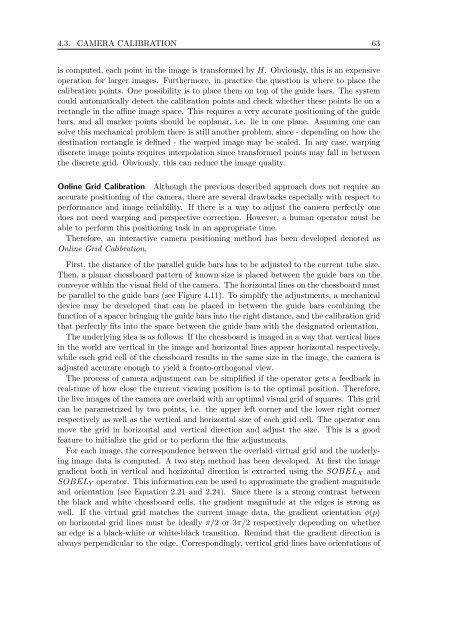Master Thesis - Fachbereich Informatik
Master Thesis - Fachbereich Informatik
Master Thesis - Fachbereich Informatik
You also want an ePaper? Increase the reach of your titles
YUMPU automatically turns print PDFs into web optimized ePapers that Google loves.
4.3. CAMERA CALIBRATION 63<br />
is computed, each point in the image is transformed by H. Obviously, this is an expensive<br />
operation for larger images. Furthermore, in practice the question is where to place the<br />
calibration points. One possibility is to place them on top of the guide bars. The system<br />
could automatically detect the calibration points and check whether these points lie on a<br />
rectangle in the affine image space. This requires a very accurate positioning of the guide<br />
bars, and all marker points should be coplanar, i.e. lie in one plane. Assuming one can<br />
solve this mechanical problem there is still another problem, since - depending on how the<br />
destination rectangle is defined - the warped image may be scaled. In any case, warping<br />
discrete image points requires interpolation since transformed points may fall in between<br />
the discrete grid. Obviously, this can reduce the image quality.<br />
Online Grid Calibration Although the previous described approach does not require an<br />
accurate positioning of the camera, there are several drawbacks especially with respect to<br />
performance and image reliability. If there is a way to adjust the camera perfectly one<br />
does not need warping and perspective correction. However, a human operator must be<br />
able to perform this positioning task in an appropriate time.<br />
Therefore, an interactive camera positioning method has been developed denoted as<br />
Online Grid Calibration.<br />
First, the distance of the parallel guide bars has to be adjusted to the current tube size.<br />
Then, a planar chessboard pattern of known size is placed between the guide bars on the<br />
conveyor within the visual field of the camera. The horizontal lines on the chessboard must<br />
be parallel to the guide bars (see Figure 4.11). To simplify the adjustments, a mechanical<br />
device may be developed that can be placed in between the guide bars combining the<br />
function of a spacer bringing the guide bars into the right distance, and the calibration grid<br />
that perfectly fits into the space between the guide bars with the designated orientation.<br />
The underlying idea is as follows: If the chessboard is imaged in a way that vertical lines<br />
in the world are vertical in the image and horizontal lines appear horizontal respectively,<br />
while each grid cell of the chessboard results in the same size in the image, the camera is<br />
adjusted accurate enough to yield a fronto-orthogonal view.<br />
The process of camera adjustment can be simplified if the operator gets a feedback in<br />
real-time of how close the current viewing position is to the optimal position. Therefore,<br />
the live images of the camera are overlaid with an optimal visual grid of squares. This grid<br />
can be parametrized by two points, i.e. the upper left corner and the lower right corner<br />
respectively as well as the vertical and horizontal size of each grid cell. The operator can<br />
move the grid in horizontal and vertical direction and adjust the size. This is a good<br />
feature to initialize the grid or to perform the fine adjustments.<br />
For each image, the correspondence between the overlaid virtual grid and the underlying<br />
image data is computed. A two step method has been developed. At first the image<br />
gradient both in vertical and horizontal direction is extracted using the SOBELX and<br />
SOBELY operator. This information can be used to approximate the gradient magnitude<br />
and orientation (see Equation 2.21 and 2.24). Since there is a strong contrast between<br />
the black and white chessboard cells, the gradient magnitude at the edges is strong as<br />
well. If the virtual grid matches the current image data, the gradient orientation φ(p)<br />
on horizontal grid lines must be ideally π/2 or3π/2 respectively depending on whether<br />
an edge is a black-white or white-black transition. Remind that the gradient direction is<br />
always perpendicular to the edge. Correspondingly, vertical grid lines have orientations of














